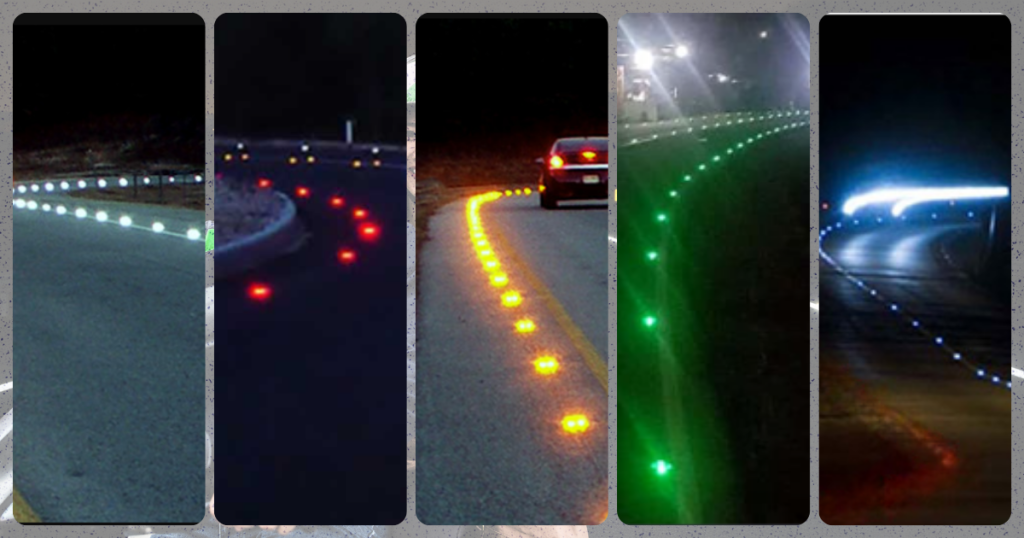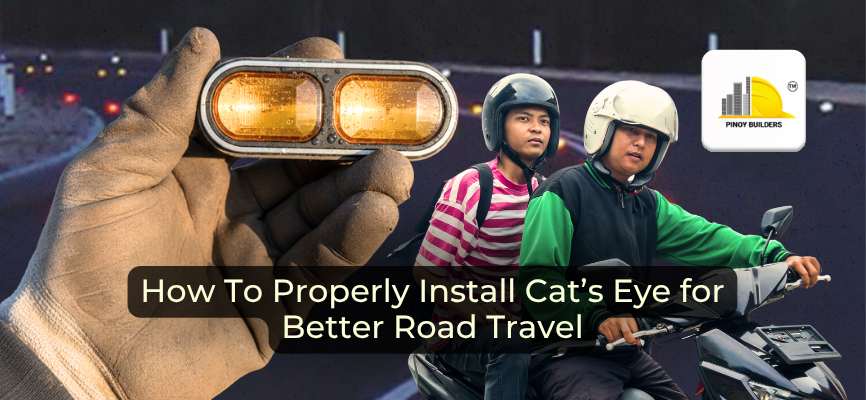Driving at night often feels different compared to daytime travel. It’s not just because there are fewer cars on the road, but also because the absence of proper road lighting becomes more noticeable.
Some areas can be very dim, and even with headlights, it can still be difficult to see the road clearly. This is where reflective markers, commonly called cat’s eyes, play an important role in guiding drivers. These small road studs shine when struck by light, helping vehicles stay in their lanes, marking road boundaries, and improving overall visibility. They may seem simple, but they contribute greatly to smoother and safer travel.
In this article, we’ll explore why cat’s eyes are essential for safer nighttime driving, go through a simple guide on how to install them properly, and highlight why more of these fixtures should be added across Philippine roads.

What Is A Cat’s Eye, and Why Do We Need Them On Roads?
Cat’s eyes, also known as reflective road studs, are small devices placed on the road surface to reflect light from vehicle headlights. They serve as a guide for drivers, especially during dark or rainy conditions.
The benefits of cat’s eyes are easy to see:
- They improve visibility at night and in bad weather.
- They enhance lane demarcation and provide clearer guidance.
- They help reduce the risk of nighttime accidents.
Cat’s eyes are commonly found on highways, urban roads, pedestrian crossings, parking lots, and roundabouts. They also follow a simple color system that communicates different messages to drivers:

White | Red | Yellow/Amber | Green | Blue |
| For lanes and centerlines | For left edges or no-entry zones | Used to separate opposing traffic | Indicates access points | Indicates emergency areas |
These small devices play a big role in keeping motorists safe and roads well-organized.
Simple Guide to Proper Installation of Cat’s Eyes
Cat’s eyes are installed on busy roads and streets, which means they need to be secured properly to ensure their durability. Improper installation processes, such as skipping necessary steps or skimping on materials, can impact a Cat’s eye’s performance on the road.
Below is a quick general guide to ensure proper Cat’s Eye installation:
Step 1: Mark the exact locations with chalk or paint.
Step 2: Drill holes if the studs require anchoring.
Step 3: Apply a strong adhesive or epoxy at each spot.
Step 4: Place the cat’s eyes firmly into position.
Step 5: Secure mechanical types by locking them properly.
Step 6: Allow at least 1–2 hours of curing time before vehicles pass through.
Test the installation under headlights at night to confirm visibility and alignment. Consistent spacing is essential for guiding drivers effectively. Standard intervals vary depending on the type of road.
- Urban roads – 3 to 5 meters apart
- Highways – 6 to 9 meters apart
- Expressways – 9 to 15 meters apart
- Curves or roundabouts – 2 to 3 meters apart
- Intersections – 3 to 4 meters apart
- Hazard zones – 1 to 2 meters, usually with red or yellow studs
What to Avoid During Cat’s Eye Installation
A few errors can reduce the effectiveness of Cat’s eyes. Installing them on wet or dirty surfaces, for example, weakens their durability and adhesive. This is why the first step in installation is cleaning the surface, either by using a drill to remove loose materials or by chipping them away with a chisel and hammer.
Another common mistake is using low-quality materials or expired adhesive. Each unit should be installed with the adhesive recommended for its specific type. To ensure the best results, it is always advisable to check with the manufacturer about which adhesive is most suitable.
Maintaining Cat’s Eyes
Installing cat’s eyes may look simple, but it requires precision to make them effective. When done correctly, these reflectors can last long and provide drivers with clear guidance at night.
Here are a few tips to help ensure proper installation and maintenance of Cat’s eyes:
- Routine cleaning: Wipe the reflectors regularly to keep them bright and visible.
- Scheduled inspections: Execute maintenance checks on the installed cat’s eyes regularly, with frequency depending on traffic volume.
- Post-weather checks: Inspect immediately after heavy rains, flooding, or road repairs, since these may loosen or damage studs.
- Quick replacements: Replace damaged or missing studs right away to maintain consistency and safety.
- Adhesive check: Monitor bonding strength; weak adhesion can cause studs to dislodge under heavy traffic.
The Need for Better Road Fixtures in the Philippines
While cat’s eyes are proven to make driving safer, many Philippine roads, especially provincial ones, still lack these reflective markers. This gap creates risks during nighttime travel, where poor visibility may cause lane drifting, collisions, and other accidents.
Improving road fixtures can change this. With more cat’s eyes and better road markings, drivers will feel more confident navigating dark or rural roads. Accident rates can drop significantly, and travel will be safer for everyone.
Adopting international standards for durability and consistency also ensures that these installations last longer and provide uniform guidance across the country.
Brighter Roads, Safer Journeys

Cat’s eyes may be small, but they make a big difference in road safety. When installed and maintained properly, they guide drivers, prevent accidents, and save lives.
Making these reflective studs more common on Philippine roads is a step toward safer nighttime driving. Brighter roads mean safer journeys for all motorists, helping every trip end on a positive note.
References
Dorji, T. (2025, July 7). Cat’s eye Road Stud: Specification, Guide and BOQ Preparation — Civil Engineering Profile. Civil Engineering Profile. Retrieved September 5, 2025, from https://civilengpro.com/cats-eye-road-stud-specification-guidelines-boq/
RoadSky. (2025, April 30). Reflective Road Stud Installation: A Step-by-Step Guide. RoadSky. Retrieved September 5, 2025, from https://roadskysafety.com/reflective-road-stud-installation-a-step-by-step-guide
Solar Road Studs. (2024, August 14). How to Install Cats Eye Road Studs? Solar Road Studs. Retrieved September 5, 2025, from https://www.haroadstud.com/blog/how-do-cats-eye-road-studs-stick-to-the-road.html
Wikipedia. (n.d.). Cat’s eye (road). Wikipedia. Retrieved September 5, 2025, from https://en.wikipedia.org/wiki/Cat%27s_eye_(road)










